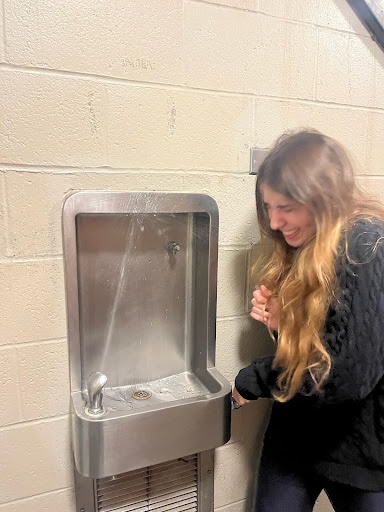
As U.S. Health Secretary Robert F. Kennedy Jr. takes a hard stance against adding fluoride to municipal water sources and as multiple states around the country outright ban the mineral’s inclusion in public water, water quality around the nation has come under more scrutiny. Kennedy has linked fluoride to adverse health effects such as bone cancer and neurological disorders, although research has not found evidence of any significant association between recommended levels of fluoridation and negative health outcomes.
To engage with the present hyper-anxiety surrounding fluoride and water quality, Jocelyn Ameo ’28 and I asked a simple, almost flippant question: Is there a difference in water quality throughout campus? Is Nicolson’s water higher quality than Bennet’s? Does Hewitt have superior water to Usdan Marketplace? What about the Allbritton Center or the Frank Center for Public Affairs (PAC)? Where’s the best water?
According to research, some water really is more refreshing than others. A study in Talanta found that more desirable waters are associated with higher concentrations of bicarbonate and sulfate, while a small study featured in Water Research determined that participants were more likely to favor waters with a high pH and high alkalinity.
“The presence of residual chlorine [does] not significantly influence [participants’] ratings [of each water],” the study notes.
This is an important metric to recognize as, according to The National Library of Health, chlorine is the most common method used to treat tap water.
Taking all of these reports into account, the tastiest, most refreshing water, scientifically speaking, is one with a pH between 7 and 8, a high alkalinity between 40 and 120 mg/L, and high levels of sulfate roughly between 100 and 150 mg/L. To find the water that tested closest to these parameters, Jocelyn and I relied on testing strips that measured the quantity of these four variables.
The procedure was simple: Submerge the test strip into the desired water for two seconds, wait an additional 30 seconds to let it dry, and then compare the results.
We started somewhere ordinary, first testing the water from the drinking fountain right outside of Summerfields. After completing our procedure, we compared the test strip to the ideal value for each parameter and found absolutely nothing out of the ordinary. The water was, in all senses of the word, average, with a pH of around 6.8, an alkalinity of roughly 50 mg/L, and a sulfate rate of roughly 120 mg/L. Summerfields water was good quality, clean, and tasted completely normal.
We then went to Exley Science Center and sampled from a water fountain. Again, we got a pH of around 6.8, an alkalinity of roughly 50 mg/L, and a sulfate rate of roughly 120 mg/L.
We then moved on to Butterfields A, B, and C water and again got the same result in all three locations. We tried Nicolson 5, 6, and 7 water, and again it was the same. We tried water from Hewitt, Usdan, North College, and Red and Black Cafe. We went to WesWings, Pi Café, and Olin Library, and we even tried the PAC water fountain which always says the filter needs to be changed, and even that was exactly the same.
We looked for the grimiest, filthiest water fountain on campus to see if that would alter our numbers at all. When we had finally narrowed it down to a barely used drinking fountain in the basement of Exley, we thought we had found our smoking gun. This had to be different, and so we placed the test tube underneath it, stuck a drinking water tester into it, and waited. 30 seconds later, we found our answer: It had a pH of around 6.8, an alkalinity of roughly 50 mg/L, and a sulfate rate of roughly 120 mg/L. It was exactly the same.
The truth of the matter is that all of the water on campus is treated, tastes good, and is of essentially the same quality. Attempting to parse differences between these equally alright waters, to us, brought up questions of media sensationalism. Would answering this question by accounting for minute—essentially negligible—variances in water quality be pointless or, at worst, be actively dangerous?
“I think that researchers often get frustrated with the way that things are portrayed in the media because it just leads to misunderstandings or lack of clarity around what the actual research findings are,” Assistant Professor of the Practice in Environmental Studies Professor Elan Abrell said. “I think that it can be helpful as a researcher to have your work covered in mainstream media…[but] with serious issues, actual confusion or complete disinformation and misinformation [can occur], depending on whether or not it’s intentional.”
Media disinformation, especially in stories covering complex sciences, can incite fear, as Abrell elaborated.
“If you listen to any interviews around bird flu, the journalists will ask The New York Times, ‘Should we panic?’ and it creates a sense of futility or inability to do anything in the face of it,” Abrell said.
Delving into the minuscule differences in water quality does nothing but confuse and potentially frighten people over minute differences. Despite our tests being based on facetious rationale, it’s interesting to think of how the variations between alternate sources of water could be portrayed. Referring back to Health Secretary Kennedy, we can ask whether his claims are simply attempts to fearmonger, and we can thoroughly examine the data on which these claims are based.
Willow Simon can be reached at wsimon@wesleyan.edu.



Leave a Reply